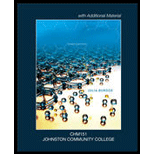
Concept explainers
Interpretation:
The different regions of the Earth’satmosphere are to be explained.
Concept introduction:
Earth’s atmosphere has many layers, which are easily identified by calculating the temperature change of the atmosphere with a change in altitude.
Answer to Problem 1QP
Solution: There are four layers in the Earth’s atmosphere. The troposphere is the closest to Earth’s surface. Above the troposphere, there is stratosphere and above the stratosphere, there is mesosphere. Thermosphere is the uppermost layer.
Explanation of Solution
The troposphere is the layer of atmosphere closest to Earth’s surface. The troposphere is the thinnest layer of Earth’s atmosphere. It includes about 80% of the total mass of air and all the water vapor of the atmosphere. The temperature decreases with increase in altitude of this region, and the air is well mixed in this region. Above the troposphere, a new region begins called stratosphere, which mainly contains ozone, oxygen, and nitrogen.
In this stratosphere, temperature increases with an increase in altitude and a slower mixing of airoccurs. Above the stratosphere, there is the mesosphere. In this, the concentration of gases and ozone is very low. The temperature decreases with increase in altitude of this region. The uppermost layer of the atmosphere is the thermosphere or ionosphere. As nitrogen, molecular oxygen, and energetic particles like protons and electronscollidewith the sun, it resultsin an increase in the temperature of this region.
The four regions of Earth’s atmosphere are troposphere, stratosphere, mesosphere, and thermosphere.
Want to see more full solutions like this?
Chapter 21 Solutions
Chemistry (Looseleaf) - With Connect Plus (Custom)
- Explain the difference between the effects of ground- level ozone and stratospheric ozone. Why is one beneficial to human life, whereas the other is not?arrow_forwardWhat is the biological importance of stratospheric ozone? Explain.arrow_forwardHow does hydraulic fracturing differ from previously used techniques for the recovery of natural gas from the earth?arrow_forward
- Chemistry: Matter and ChangeChemistryISBN:9780078746376Author:Dinah Zike, Laurel Dingrando, Nicholas Hainen, Cheryl WistromPublisher:Glencoe/McGraw-Hill School Pub Co

 ChemistryChemistryISBN:9781305957404Author:Steven S. Zumdahl, Susan A. Zumdahl, Donald J. DeCostePublisher:Cengage Learning
ChemistryChemistryISBN:9781305957404Author:Steven S. Zumdahl, Susan A. Zumdahl, Donald J. DeCostePublisher:Cengage Learning 
 Chemistry: An Atoms First ApproachChemistryISBN:9781305079243Author:Steven S. Zumdahl, Susan A. ZumdahlPublisher:Cengage Learning
Chemistry: An Atoms First ApproachChemistryISBN:9781305079243Author:Steven S. Zumdahl, Susan A. ZumdahlPublisher:Cengage Learning Chemistry for Engineering StudentsChemistryISBN:9781337398909Author:Lawrence S. Brown, Tom HolmePublisher:Cengage Learning
Chemistry for Engineering StudentsChemistryISBN:9781337398909Author:Lawrence S. Brown, Tom HolmePublisher:Cengage Learning





